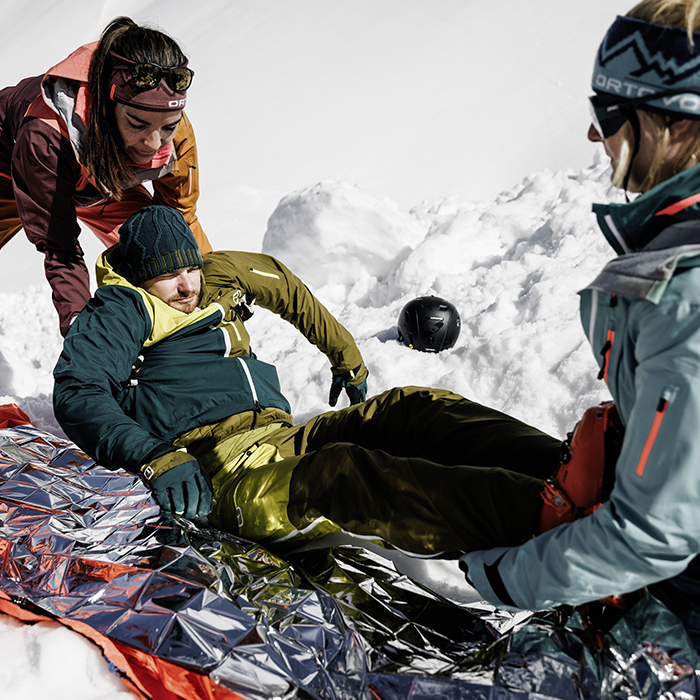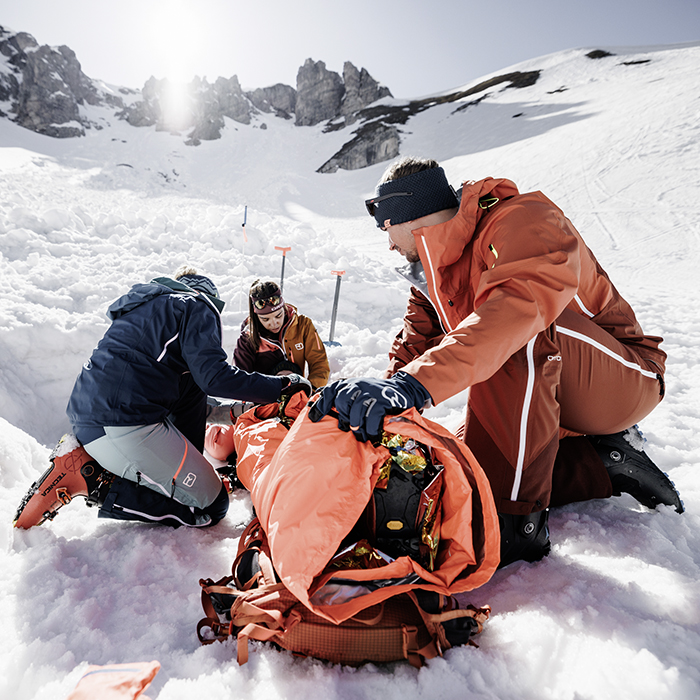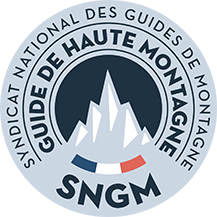


FIRST AID IN AN AVALANCHE ACCIDENT
First aid begins with preparation. In addition to your personal emergency equipment (avalanche transceiver, probe and shovel), every ski touring backpack should also include a first aid kit, bivy bag, cell phone and an emergency card containing all your important personal information and contact details. This ensures the responder has what they need to locate the burial victim, provide them with medical care and alert the rescue services.
NOTE: The theoretical foundations are by no means a replacement for comprehensive first aid training. All ski tourers should have learned and practiced practical first aid techniques on a combined avalanche transceiver and first aid course!
Ensuring the victim has a clear airway is the top priority. Therefore, their head must be uncovered as quickly as possible. As soon as a shovel has made contact with the burial victim, you must find out where the head is located so you can continue digging in that direction. In order to avoid additional injury, you should continue shoveling quickly but carefully – toward the end it is best to use your hands.

ACCIDENT VICTIM IS RESPONSIVE
If the accident victim is responsive, you should check their body for injuries following the algorithm, position them comfortably, ensure they are kept warm and provide psychological support until the rescue service arrives.
CHECKING AND SECURING THE AIRWAY
As soon as the victim’s head has been uncovered, you should check their breathing. If there are several helpers on site, the others should continue shoveling to completely free the burial victim, while the first responder checks the breathing.
Any snow in their mouth should be removed as well as possible, then the breathing check can be performed. To do this, the first responder should roll the accident victim onto their back, tilt the victim’s head back, and place one hand on the victim’s stomach; they should then bend over them, with their ear over the victim’s mouth. The first responder then checks for breath for 10 seconds by listening (for breathing noises), looking (for movement of the ribcage) and feeling (for breath on their cheek or movement of their hand on the stomach).
If the person cannot be rolled onto their back, their breathing should still be checked as best possible.
WARNING: Any bleeding must be stopped immediately and takes priority over everything!

RECOVERY POSITION
If two regular breaths are identified within the 10 seconds of the check, the accident victim should be placed in the recovery position. The recovery position ensures that airways remain open and liquid, vomit or blood can flow out. This prevents the accident victim from choking.
Here, it’s useful to lay out a 2-person bivy bag in front of the accident victim so they can be immediately rolled onto it.
PROCEDURE
-
Kneel down on the downhill side of the unconscious person
-
Lay their near-side arm at a 90° angle next to them
-
Bend their far-side leg and hold in place
-
Hold their far-side hand, lay the back of the hand on their cheek (the one facing towards you) and hold in place
-
Turn the injured person toward you at the knee
-
Carefully pull your own hand out from under the injured person’s head so that they are lying only on the back of their hand
-
Tilt their head backward
-
Open their mouth slightly. The mouth should be slightly lower than their stomach, so that blood or vomit can run out.
The now stabilized, unconscious person should be wrapped up warm.
Their breathing should be checked regularly at short intervals and they should be continuously supervised until mountain search and rescue arrive.
EMERGENCY CALL
If there are several helpers available, the emergency call will already have been made at the beginning of the avalanche transceiver search. If the first responder is alone, the avalanche transceiver search and the subsequent movement of the person into the recovery position to secure their breathing have priority. Only then should the emergency call be made in this case.

RESUSCITATION
If you cannot identify two regular breaths within the 10 seconds of the breathing check, begin resuscitation immediately.
If the victim is not breathing properly and the professional rescue service has not yet been alerted (e.g. because there is only one helper), the emergency call should be made now – before beginning resuscitation.
CHEST COMPRESSIONS
-
Kneel next to the lifeless person in line with their ribcage.
-
Place the heel of one hand on the center of the ribcage. Place your other hand on top of it and link your fingers. Keep your arms straight.
-
Use your own body weight to push the lifeless person’s chest down five to six centimeters. Apply pressure firmly and quickly!
-
Completely remove pressure from the ribcage after every chest compression.
-
After 30 chest compressions, give mouth-to-mouth/nose twice: Close the nose with one hand while placing the other on the person’s chin and tilting their head backward. Breathe in normally and then place your lips around the accident victim’s mouth and breathe out normally.
Perform chest compressions and mouth-to-mouth/nose in a ratio of 30:2 until professional help (mountain rescue / emergency doctor) has arrived or you are exhausted.




HEAT MAINTENANCE AND MENTAL HEALTH CARE
It is very important to keep a person who has been dug out of an avalanche nice and warm. While the helpers will generally be very warm from shoveling and moving around on the avalanche deposit zone, the accident victim will get colder and colder. While cooling down will take longer within the snowpack than on the surface, the burial victim should nevertheless be uncovered as quickly as possible, wrapped up warm and, depending on their condition, well positioned.
PROVIDING WARMTH
It is very important to keep a person who has been dug out of an avalanche nice and warm. While the helpers will generally be very warm from shoveling and moving around on the avalanche deposit zone, the accident victim will get colder and colder. While cooling down will take longer within the snowpack than on the surface, the burial victim should nevertheless be uncovered as quickly as possible, wrapped up warm and, depending on their condition, well positioned.
Whether the person is conscious, responsive or non-responsive – if they are breathing, they should be kept warm and protected from wind, weather and cold as quickly as possible. Warmth only plays a less important role if the person is not breathing properly and needs to be resuscitated. Nevertheless, it is recommended to ensure that only the top half of the body is stripped down or that the base layer of clothing is left on. Wrapping the rest of the body up warm does not have priority.
A two-person bivy bag works well for wrapping up an accident victim. Injured people will have difficulty crawling into a bivy bag, because generally every movement will be painful. Therefore, the bivy bag should be used as a blanket.
The accident victim should be laid on a bivy bag, covered with as much clothing as can be spared (without endangering yourself), and then wrapped in a rescue blanket. The edges of the bivy bag should be wrapped around the person, who should be wearing a beanie and – if possible – gloves. If their beanie and gloves have gone missing in the avalanche and nobody has spares, other soft materials should be used.
It makes sense to protect them against cold from below. A bed made from backpacks is very well suited for this.
Sinnvoll ist auch ein Kälteschutz von unten. Dafür ist ein Rucksackbett sehr gut geeignet.
BACKPACK BED
A bed of backpacks will give an injured person something soft and warm to lie on, preventing the cold ground from cooling them down.
A backpack bed requires several backpacks. Everything that is still required (clothing, food, drink, cell phone, first aid kit) should be removed from the backpacks, as well as all hard and breakable objects such as glasses.
Then the backpacks should be placed in a row next to each other with back part facing up.
The injured person, who is already wrapped up warm in a bivy bag, can now be lifted onto the backpack bed by grabbing the bivy bag and hefting the person up onto it. Now they are also optimally protected against cold from below.
When warmth has been ensured, the next thing to do is wait for mountain search and rescue. Psychological support plays a key role during the wait.
PSYCHOLOGICAL SUPPORT
It is enormously important to provide an accident victim with psychological support. A person who has been buried in an avalanche is experiencing a traumatic situation combined with fear of death and suffocation panic. Added to this can be pain from injuries and a great sense of panic because the person under the avalanche’s mass of snow was unable to move.
This person is very dependent on getting friendly care and attention, and upon being calmed by the first responder. The first responder should – despite their own exceptional situation – be there for the burial victim on a human level, look after them well, comfort and talk to them.
This also applies to unconscious persons who are still breathing. As a rule, they also hear and understand a great deal, and will benefit hugely from good psychological support and encouragement.



Get help
While in some mountain regions there can be good cell reception even at an altitude of 4,000 meters, in other secluded regions it may be impossible to make an emergency call with a cell phone. Here the alpine distress signal is the means of communication. The distress signal can also be helpful for mountain search and rescue if they are having trouble locating the exact accident site.
If the rescue team comes by air, it provides useful information that makes working with the helicopter easier.
When should you make an emergency call?
There is an easily identifiable point in time: when you feel that you cannot solve the problem in the mountains (accident, illness, mountain emergency) yourself. As soon as you are unsure whether you need help or not, or are at least thinking about making an emergency call, you are already in internal deliberation mode. In this case: Stop! Now is the time to make an emergency call.
Which number should you call?
In Europe, you can always call the European emergency number, 112. This number will put you in touch with help. This might not be the rescue coordination center in every country; it could, for example, be the police. There are national numbers that will allow you to contact the rescue coordination center directly.
The advantages of 112:
-
Priority signal in the network – if the network is overloaded, normal conversations will be broken off to ensure this call gets through.
-
It always uses the network with the strongest reception – if your provider currently has a poor network connection, a different network – the strongest one – is automatically chosen.
-
If your network provider has no reception, the strongest available network will be used.
-
No call charges – this number works even with an empty prepaid SIM.
-
The call goes to the closest rescue coordination center.

AML function
Nowadays, smartphones have an AML (Advanced Mobile Location) function. If a rescue service control center has AML capability, your GPC coordinates will automatically be sent to the call handler, making things much easier. However, you cannot rely on this because not all rescue coordination centers and police stations have this technology yet.
SMART LOCATING SYSTEMS
Some rescue coordination centers and the Mountain Rescue have a smart locating system. The call hander or mountain rescue head of operations can use this to send the caller a text containing a link. When the caller clicks on the link, the rescue services will receive the GPS coordinates. This allows them to determine the caller’s location.
Nevertheless, the mountain rescue head of operations or call handler will confirm that the location indicated in the mountains matches the caller’s actual location.
GPS coordinates
Every cell phone can be used to determine your own GPS coordinates. To do this, either use the preinstalled app on your cell phone or download a GPS app.
Speak slowly and clearly when reading the coordinates to the call handler. The call handler will repeat the coordinates and then, as a rule, describe the location that this indicates on their screen.
Are you unsure where to find your GPS coordinates? Then take a moment at home to find out so that you can quickly determine your location in an emergency.
There are some very good apps that can help you make an emergency call.
However: Despite the many modern technological options, you should always know where you are; you should always be able to describe your location as accurately as possible (elevation, trail number, destination summit, starting point, features such as wayside crosses, etc.), or be able to find it on a topo. Even the very latest technology can fail, every battery empties now and again... in these cases you should still be able to determine your location in the mountains.
Here are a few apps that will help you to determine your location:
SOS EU ALP app
This is the official rescue coordination center app for Bavaria, Tyrol and South Tyrol. In these areas, this is the only app that automatically dials the emergency number and directly sends your GPS coordinates to the rescue coordination center when you click on “REPORT AN EMERGENCY”.
ECHO SOS app
This app has the relevant emergency numbers for almost every country on the planet (police / rescue services / fire department). If set to the country you are currently in, the app will automatically select the emergency number for that country and send your GPS coordinates to the app provider’s central server when you make the emergency call.
The rescue coordination center can then input the caller’s cell number on the website www.echosos.com to get your location using the GPS coordinates.
WHAT3WORDS app
This app has divided the globe into a grid of 3-meter squares and given every square a unique combination of three words, known as a three-word address, e.g. tins.identity.form. If you want to know where that is, go to the website www.what3words.com and enter the three words or click directly on www.what3words.com/tins.identity.form.
During the emergency call, you can give the call handler your three-word address, providing them with your location.
HILFE IM WALD app
This app is great for use in Germany. All of the official forest rescue points are marked in it. In the Central Uplands, this is often the only way of properly determining your location. This app will show you your location and determine where the closest rescue point is. If you click on this rescue point, you will see its unique number and can tell the call handler on the emergency call, for example: “We are 300 meters east of rescue point GAP103.”
This generally makes you very easy for rescue services to find.
For a detailed explanation of these apps and all issues relating to emergency calls, see https://www.danihornsteiner.de/notruf/notruf-ganz-einfach/ (website in German).
If you cannot make an emergency call because you have no reception even via 112, you can do the following:
- Try all of the cell phones available to you. Maybe someone else at the accident site has reception.
- Do you perhaps have a data connection but no network connection? Send a chat message to one of your emergency contacts (who you should have informed and saved in advance). The chat message should be short and sweet: “112, accident location, problem”. The recipient can use this to make the emergency call, pass on the information and then answer briefly.
- Walk a few meters to a crest or behind a curve – you might get reception there.
- Are there other people nearby? Are there more people in the group? If there are, one person should stay with the accident victim and one or, preferably, two should walk until they get reception. The latter should be able to describe the accident location accurately or have the GPS coordinates saved.
Alpine distress signal
-
If you are alone and there is nobody close by, you can try to call attention to yourself using the alpine emergency signal:
-
An audible or visible signal 6x in a minute
-
Answer: An audible or visible signal 3x in a minute
-
If you do not receive an answer within a reasonable amount of time, you must move away from the accident victim to find reception. Make sure that the accident victim is cared for to the best of your ability, is kept warm and is aware of when you will be returning. Be generous with the time you tell them to ensure you have enough of a buffer to cover all eventualities. Ensure you can describe the accident location accurately or take a screenshot of the location coordinates.

You’ve made the emergency call and air rescue has been informed. Air rescue are professionals, but the first responder can still make their work easier en route and protect themselves and the accident victim from hazards. The optimal course of action looks like this:
- The helicopter approaches the accident scene. Show the pilot that help is needed by stretching both arms in the air to signal “YES – HELP”.
- Shortly before landing the helicopter often makes a recon approach before turning away and then returning. The first responder should not panic if the helicopter turns away. When the helicopter makes it landing approach, the first responder and the accident victim should get to a safe place and crouch down until the helicopter has landed.
- The wind caused by the rotors will cause a downwash that may swirl up loose objects and snow. Therefore, all equipment should be secured to prevent anything flying around. In winter, the injured person and all helpers should be well “wrapped up”; i.e. as many zippers as possible should be zipped all the way up and your hood should be up and tightened.
- The helicopter lands. Either the crew will come directly to the responder and the accident victim or give the signal to approach the helicopter.







